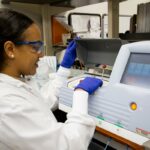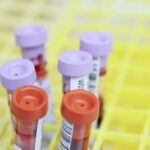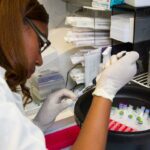The intricate dance of life on Earth is governed by the principles of evolution and the blueprint of DNA. Evolution, the process of change in all forms of life over generations, and DNA, the molecule that carries the genetic instructions for the development, functioning, growth, and reproduction of all known organisms, are intrinsically linked. This article aims to explore the fascinating relationship between these two fundamental aspects of life.
Understanding the Basics of Evolution
Definition and Explanation of Evolution
Evolution is a process that results in heritable changes in a population spread over many generations. It is a complex process that includes mechanisms like mutation, migration, genetic drift, and natural selection. The concept of evolution is fundamental to understanding life on Earth, as it explains the diversity and shared characteristics among organisms.
The Role of Natural Selection in Evolution
Natural selection is the primary mechanism of evolution. It is the process by which species adapt to their environment. Natural selection leads to evolutionary change when individuals with certain characteristics have a greater survival or reproductive rate than other individuals in a population and pass on these inheritable genetic characteristics to their offspring.
The Concept of Genetic Mutations
Genetic mutations are changes in the DNA sequence of a cell’s genome and are the main cause of diversity among organisms. These changes can occur spontaneously or as a result of exposure to radiation or toxins. Mutations can be beneficial, harmful, or neutral, but all contribute to the process of evolution by providing a source of genetic variation.
The Connection Between Evolution and DNA
How Evolution Affects DNA
Evolution acts on the DNA of organisms. Over time, beneficial mutations are preserved because they aid survival — a process known as “natural selection.” These beneficial mutations are passed on to the next generation. Over time, this process can lead to organisms with new characteristics.
The Process of Genetic Variation in Evolution
Genetic variation is a crucial factor in evolution. Without variation, some of the basic mechanisms of evolutionary change cannot operate. There are three primary sources of genetic variation, which are the ultimate source of new genes and new genetic combinations: mutation, recombination, and gene flow.
Case Studies: Evolution Changing DNA
Evidence of Evolution Changing DNA in Different Species
There are numerous examples of evolution changing DNA in different species. For instance, the evolution of the horse, from the small, forest-dwelling Eohippus to the modern horse, is well documented in the fossil record. This evolution has been accompanied by changes in the horse’s DNA, as revealed by genetic studies.
Detailed Analysis of Specific Cases
One of the most well-studied cases of evolution changing DNA is the evolution of antibiotic resistance in bacteria. As bacteria are exposed to antibiotics, those with mutations that allow them to survive will reproduce, passing on these advantageous genes to their offspring. Over time, the population of bacteria evolves to become resistant to the antibiotic.
The Role of Genetic Mutations in Evolution
Understanding Genetic Mutations
Genetic mutations are random changes in the genetic material of organisms. They can occur spontaneously or be induced by environmental factors such as radiation or chemicals. While most mutations are neutral or harmful, some can confer an advantage and be favored by natural selection, leading to evolutionary change.
How Genetic Mutations Contribute to Evolution
Genetic mutations are the raw material of evolution. Without mutation, evolution could not occur, as there would be no variation for natural selection to act upon. Mutations introduce new genetic variation, and natural selection “chooses” the most beneficial mutations, leading to evolutionary change.
The Impact of Genetic Mutations on DNA
Genetic mutations can have a profound impact on DNA. They can change the sequence of DNA, leading to changes in the proteins that the DNA codes for. These changes can affect an organism’s phenotype, or physical traits, which can influence its fitness and thus its ability to survive and reproduce.
Natural Selection and DNA
Explanation of Natural Selection
Natural selection is the process by which traits become more or less common in a population due to consistent effects upon the survival or reproduction of their bearers. It is a key mechanism of evolution.
The Relationship Between Natural Selection and DNA Changes
Natural selection acts on the phenotype, or physical traits, of an organism. These traits are determined by the organism’s genotype, or genetic makeup, which is encoded in its DNA. Thus, natural selection indirectly leads to changes in DNA over time.
Examples of Natural Selection Leading to DNA Changes
A classic example of natural selection leading to DNA changes is the evolution of the peppered moth in the UK. Prior to the industrial revolution, the majority of peppered moths were of a light coloration which camouflaged them against the light-colored trees and lichens. However, due to widespread pollution during the Industrial Revolution in England, many of the lichens died out, and the trees that peppered moths rested on became blackened by soot, causing most of the light-colored moths to die off from predation. At the same time, the dark-colored moths flourished because of their ability to hide on the darkened trees.
Evolution and DNA Symbiotic Relationship
How Evolution and DNA Influence Each Other
Evolution and DNA have a symbiotic relationship. Evolution acts on the DNA of organisms, favoring those with beneficial mutations. At the same time, the DNA of organisms influences their ability to survive and reproduce, which in turn influences the course of evolution.
The Ongoing Cycle of Evolution and DNA Changes
The relationship between evolution and DNA is a continuous cycle. Changes in DNA can lead to new traits. If these traits are beneficial, they can be favored by natural selection, leading to evolutionary change. This change, in turn, can lead to further changes in DNA, and so on.
The Future of Evolution and DNA
Predictions for Future DNA Changes Due to Evolution
Predicting future DNA changes due to evolution is challenging, as evolution is a stochastic process. However, scientists can make educated guesses based on current trends. For instance, it is predicted that humans will continue to evolve in response to a changing environment, leading to changes in our DNA.
The Potential Impact of These Changes on Species and Ecosystems
Changes in DNA due to evolution can have profound impacts on species and ecosystems. For instance, the evolution of antibiotic resistance in bacteria is a major concern for public health. On a larger scale, changes in the DNA of key species can lead to shifts in ecosystem dynamics.
Debunking Myths about Evolution and DNA
Common Misconceptions about Evolution and DNA
There are many misconceptions about evolution and DNA. For instance, some people believe that evolution is a linear process, with organisms evolving from “lower” to “higher” forms. However, this is not the case; evolution is a branching process, with all organisms evolving from a common ancestor.
Scientific Evidence Debunking These Myths
Scientific evidence overwhelmingly supports the theory of evolution and the role of DNA in this process. For instance, the fossil record provides clear evidence of evolution, with organisms showing change over time. Similarly, genetic studies have shown that DNA changes over time, providing further evidence of evolution.
Wrap-up
The relationship between evolution and DNA is a fascinating one. Evolution acts on the DNA of organisms, leading to changes in their traits. These changes, in turn, can influence the course of evolution. Understanding this relationship is crucial for understanding life on Earth.
Frequently Asked Questions
What is evolution?
Evolution is a process that results in heritable changes in a population spread over many generations.
How does evolution affect DNA?
Evolution acts on the DNA of organisms. Over time, beneficial mutations are preserved because they aid survival — a process known as “natural selection.” These beneficial mutations are passed on to the next generation.
What is a genetic mutation?
Genetic mutations are changes in the DNA sequence of a cell’s genome and are the main cause of diversity among organisms.
How do genetic mutations contribute to evolution?
Genetic mutations are the raw material of evolution. Without mutation, evolution could not occur, as there would be no variation for natural selection to act upon.
What is the relationship between natural selection and DNA?
Natural selection acts on the phenotype, or physical traits, of an organism. These traits are determined by the organism’s genotype, or genetic makeup, which is encoded in its DNA. Thus, natural selection indirectly leads to changes in DNA over time.
Can we predict future DNA changes due to evolution?
Predicting future DNA changes due to evolution is challenging, as evolution is a stochastic process. However, scientists can make educated guesses based on current trends.
References
- Futuyma, D. J., & Kirkpatrick, M. (2017). Evolution. Sinauer Associates is an imprint of Oxford University Press.
- Ridley, M. (2004). Evolution (3rd ed.). Blackwell Publishing.
- Alberts, B., Johnson, A., Lewis, J., Raff, M., Roberts, K., & Walter, P. (2002). Molecular Biology of the Cell (4th ed.). Garland Science.
- Dawkins, R. (2006). The Selfish Gene (30th anniversary ed.). Oxford University Press.
- Lenski, R. E., & Travisano, M. (1994). Dynamics of adaptation and diversification: a 10,000-generation experiment with bacterial populations. Proceedings of the National Academy of Sciences, 91(15), 6808-6814.
- Majerus, M. E. N. (1998). Melanism: Evolution in Action. Oxford University Press.








